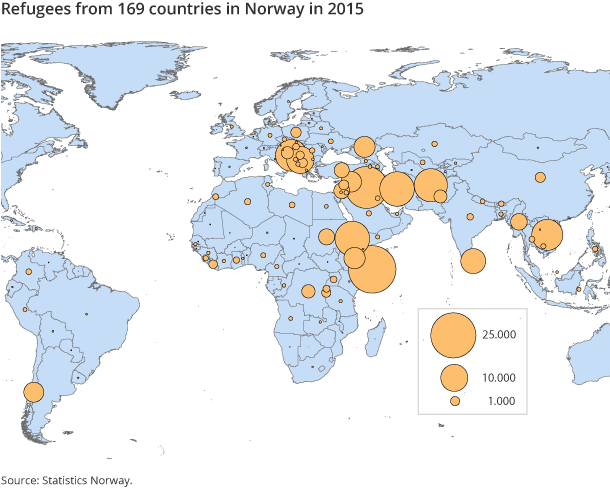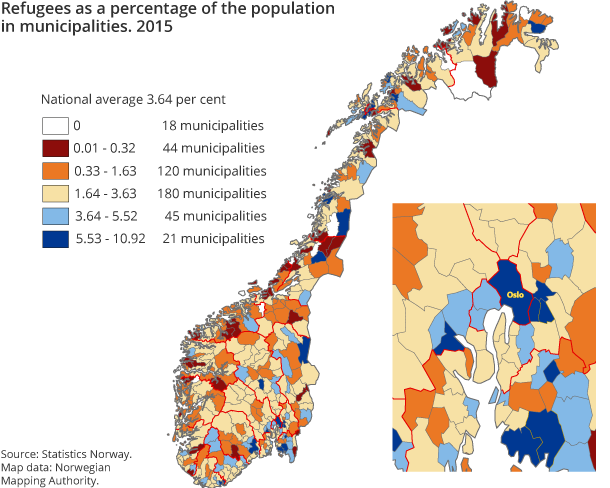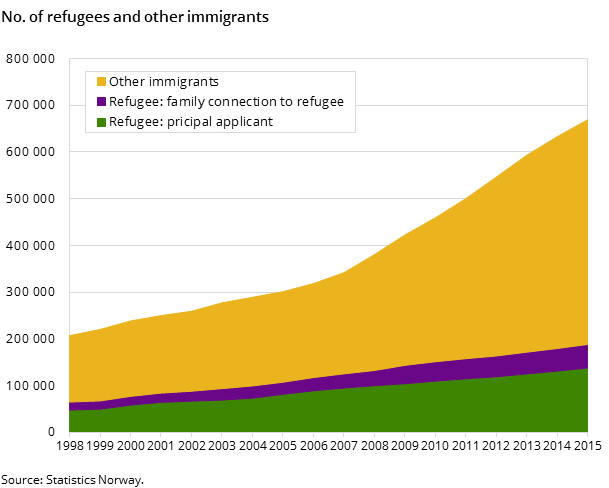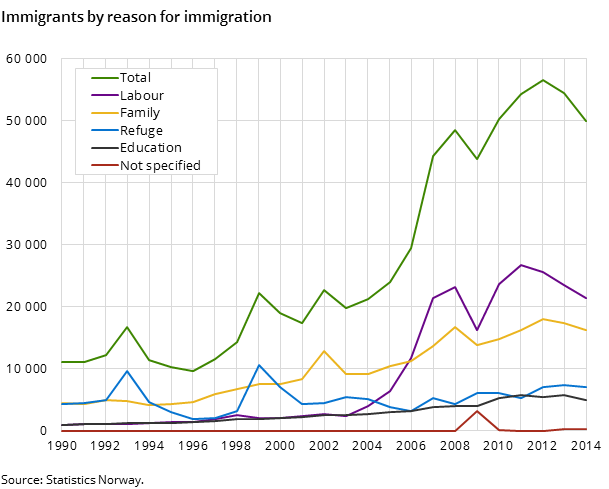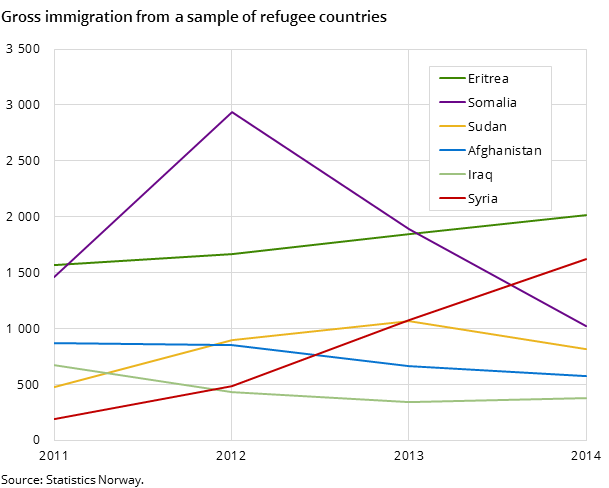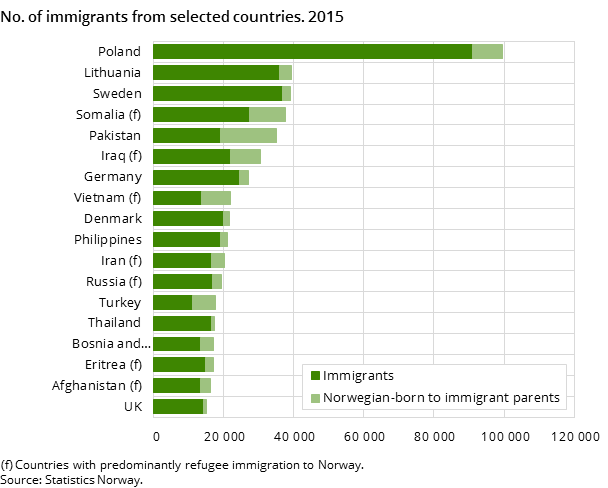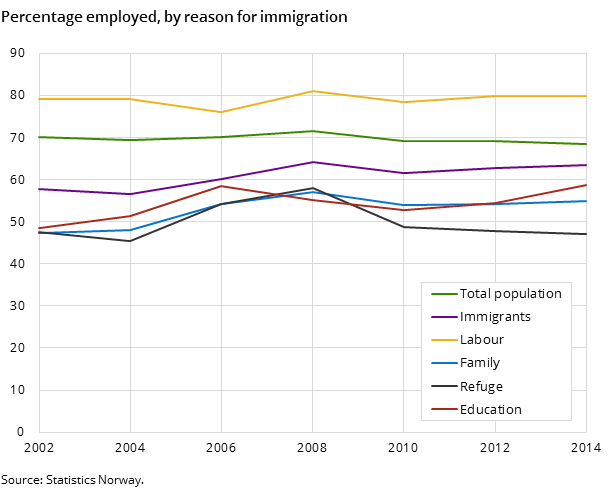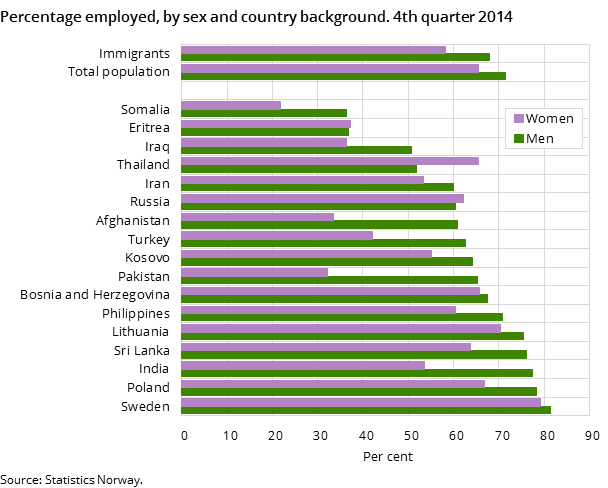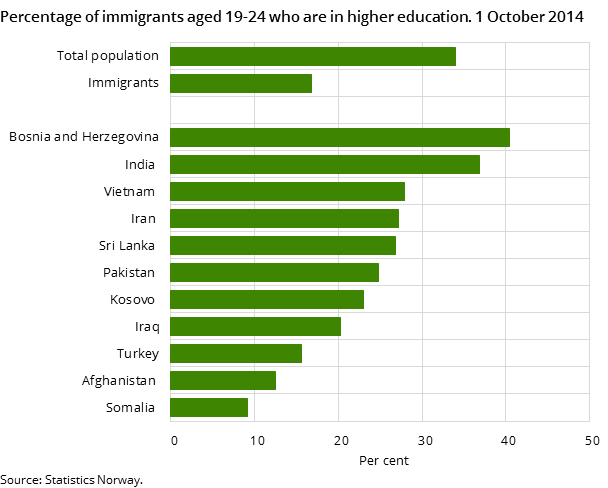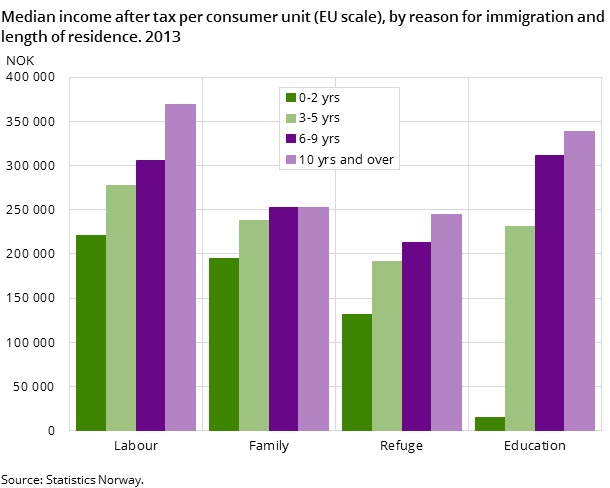Refugees in Norway
Published:
This article was originally written in Norwegian for World Statistics Day on 20 October 2015, and updated for the International Migrants Day on 18 December 2015. Figures in the article were updated to reflect the preceding two months’ growth in asylum seekers to Norway.
The large influx of refugees is headline news throughout Europe, including Norway. However, despite all the attention, only a very small percentage of the refugees have found their way to Norway so far (UNHCR 2015). It is nevertheless evident that Norway is experiencing record numbers of asylum seekers and refugees.
In recent months, the record influx of refugees into Europe has been a top news story across Europe. The situation has also been followed with great interest in Norway. But to date only a very small percentage, from a few countries, have made their way to Norway. This article examines the number of refugees living in Norway today, and the extent to which they have participated in the education system and labour market. We also present some figures and findings on asylum seekers in 2015.
It's not just the content of the news story that is important; the terms and definitions used and how the situation is portrayed have a large impact on how a story is interpreted. It may focus on the 3 year-old, Aylan Kurdi, whose body was washed up on a beach in Turkey on 4 September. Or we can report that the boats in the Mediterranean Sea are filled, not just with refugees fleeing war in Syria, but with fortune seekers, particularly from Africa, who are seeking to live in Europe in unprecedented numbers. In Norway, we can emphasise that the forecasted immigration from Syria could cost us NOK 430 billion, or we can present the cost as 0.53 øre per day per capita for the remainder of this century. Neither of these approaches are inherently wrong, but when empirical data is selected based on such different perspectives, it is easy to see how disagreements can arise on which knowledge base should be used to throw light on the situation. It is important to use accurate and unambiguous definitions in the descriptions, and to be aware of how we define and use certain terms and on what basis. Such terms include: resettlement refugees, refugees, migrants, immigrants, asylum seekers and asylum seekers who are granted residence. Over the autumn, it has become increasingly common to refer to those crossing the Mediterranean as ‘refugees and migrants’, thereby perhaps implying a distinction between the ‘worthy needy’ and ‘fortune seekers’. We must also clearly distinguish between actual observations (for which period they are made, and using what methods) and figures on future arrivals (if they are targets, expectations, projections, forecasts, etc.). It is particularly important to make the basis for comparison absolutely clear when comparing countries and periods of time.
Asylum seekers from Syria to Europe were in the minority in 2015
Europe has seen a large influx of refugees and migrants over a long period of time, and the number is increasing rapidly (OECD 2015). Media coverage has centred around the Syrian refugees, many of whom will be granted asylum following their arrival in the country they want to flee to. Germany and Sweden seem to be prepared to grant asylum to all of the war refugees from Syria who apply. By doing so, they are effectively disregarding the Dublin Regulation, which gives countries the right to return refugees to the first EU or EFTA country they arrived in. The Syrians, however, do not make up the majority of the influx to Europe. OECD (2015) shows that only 14 per cent of asylum seekers who arrived in the EU in the first quarter of 2014 and 2015 were from Syria.
The number of Syrians seeking asylum in Norway was relatively high in the autumn of 2015, but their share of the overall influx has fallen (UDI 2015). If we assume that the UDI’s current practice will continue (UDI 2015), the majority will probably be granted permission to stay, perhaps with the exception of those coming via counties where they have stayed legally for shorter or longer periods. Even if there was a quick resolution for peace and stability in Syria, refugee camps in neighbouring countries will still be home to millions of people and hundreds of thousands more will still be making their way to or passing through Europe.
Since September, more than half of the asylum seekers to Norway have been from Syria.
A total of 30 110 asylum seekers arrived in Norway in the first 11 months of the year; an increase from around 500 per month in the spring to more than 8 000 in both October and November (table 1). Since mid-November, the number of new asylum seekers has seen a sharp drop, from a record 2 500 one week in mid-November to 363 and 285 in the first and second weeks of December respectively, which are the lowest weekly figures since June.
This sharp decline in the number of asylum seekers was concurrent with the parliament passing a range of proposals (11.19.2015) to tighten the asylum policy (Regjeringen.no, 2015), which followed weeks of intense debate in the media. The individual measures scarcely had any immediate impact, but as an indication of policy tightening their effect is likely to be more far-reaching. While Norway was tightening its policy, crossing the Danish and Swedish borders became much more difficult for those who wanted to get into Norway, and in the first week of December not one asylum seeker crossed the Norwegian-Russian border at Storskog in Finnmark. Furthermore, fewer are tempted to cross the Mediterranean on their way to Europe in the autumn and winter due to poorer weather, and this will also have played a role. All of these factors have no doubt contributed to the sharp decline in the number of asylum seekers from the second half of November to the start of December. Estimated numbers for the weeks and months ahead are as yet unknown.
In total, more than half of the asylum seekers to Norway in 2015 were from Syria, but the breakdown has changed considerably during the year. In the first five months of the year, 13 per cent of asylum seekers were from Syria. In September, the share passed 50 per cent, where it remained during the first half of October. In November, the share fell again to 30 per cent. The number and the share who came from Afghanistan increased in 2015 and was higher in November than the number from Syria. For the year as a whole, Afghanistan is a clear number two behind Syria. Iraq’s share increased in the autumn. In the first few months of the year only a few per cent of asylum seekers were from Iraq, but in the year up to November the figure was 10 per cent. Eritrea was the country with the most asylum seekers in Norway for a number of years, but in the second half of 2015 the picture changed dramatically, and up to December less than 10 per cent of asylum seekers were from Eritrea. Both in relative and absolute terms, there is a drop in asylum seekers from Somalia, and compared with the rest of Europe, asylum seekers from the former Yugoslavia and Albania make up a small minority. We also still get very few asylum seekers from African countries other than Eritrea, Ethiopia and Somalia.
We do not know how many recent asylum seekers will be granted protection in Norway. Of the more than 10 000 decisions made by UDI up to the end of November, almost 20 per cent were refusals and more than 20 per cent did not receive a substantive decision either because another country was responsible for the application under the terms of the Dublin Regulation or the applicant could be returned to a safe third country. Fifty-five per cent of those who applied were successful. One in four applications from Syria did not receive a substantive decision in Norway, and the remainder were permitted to stay here. More than 90 per cent of applications from Eritrea had a positive response, while a third from Afghanistan did not receive a substantive decision in Norway.
Of Germany's 262 000 asylum seekers in the first nine months of the year, 25 per cent were from Syria. Only 5 per cent were from Afghanistan or Iraq, and 3 per cent were from Eritrea. Asylum seekers from the former Yugoslavia and Albania totalled more than 100 000 (40 per cent), but most of them will probably be returned as quickly as possible (MPI 2015). The breakdown of Sweden’s 149 000 asylum seekers more closely resembles the Norwegian figures than the German breakdown, but the concentration of a few countries is smaller in Sweden (SCB 2015). The share from Syria has been about 40 per cent throughout the year, followed by Afghanistan, Iraq and Eritrea. These four countries together account for three-quarters of the asylum seekers to Sweden.
It has been said that many of those who cross the Mediterranean are from countries in sub-Saharan Africa, and that these people have the least grounds for asylum. Asylum is granted to many from the Horn of Africa. Furthermore, there are a few thousand asylum seekers from Nigeria in Germany, while there are not many from sub-Saharan Africa who seek asylum in Sweden or Norway (UNHCR 2015).
3.6 per cent of Norwegian population are refugees
At the start of 2015, 188 000 persons with a refugee background were living legally in Norway. A total of 138 000 have refugee status, 35 000 (25 per cent of the total refugees) have come through family reunification with a refugee and 15 000 through the establishment of a family with a refugee. The 188 000 refugees come from a total of 169 different countries (figure 1), mostly from Somalia, Iraq and Iran (see figure 6). Of the 138 000 with refugee status, approximately 90 000 are asylum seekers whose application was successful, 28 000 are resettlement refugees, and almost 20 000 fall under the category ‘Other’ or ‘Unspecified’ (Statistics Norway 2015a). Many of the 20 000 are people from Bosnia and Herzegovina who were granted collective protection in the early 1990s. The refugees constitute a significant share of the immigrants in Norway (28 per cent), and make up 3.6 per cent of the total population (table 2).
Figure 2 shows that refugees reside in all parts of Norway. Eighteen municipalities have no refugees, which is just a fifth of the 2012 figure (Østby et al. 2013). Many of the municipalities with the most immigrants in both absolute and relative terms also have many refugees. Nevertheless, there are some interesting divergences from this pattern. Oslo has the most immigrants, both in absolute and relative terms, as do many of the surrounding municipalities, Drammen, the other cities and some municipalities along the coast (Østby et al. 2013). The largest shares of refugees are found in Vadsø, Nesna, Hattfjelldal and Drammen, where they constitute 7.5 to 11 per cent of the population. The shares are also high in other small rural municipalities, some of which have large numbers living in reception centres. However, those living in reception centres are not normally registered as resident in the host municipality unless they have been granted asylum.
Many of those who receive a positive response to their application for asylum remain in the reception centre for many months before they are resettled in a municipality. At the start of 2015, this applied to around 5 000 refugees; about a third of the 14 500 who were in reception centres (UDI, 2015). Refugees are normally issued with a personal identification number when they are granted asylum, and for the period they remain in the reception centre they are normally registered as resident in that municipality. In some municipalities, more than half of the residents in reception centres were waiting to move to their resettlement municipality, and in small municipalities with large reception centres this group can push up the share of refugees in the municipality.
In Oslo and a number of neighbouring municipalities, 6 to 7 per cent of the inhabitants have a refugee background, and Kristiansand, Skien and Fredrikstad are also in the highest category (over 5.53 per cent) in figure 2. Bergen, Stavanger and Trondheim are around the national average, and there are few refugees in many remote areas.
Years following 2005 see strongest growth in labour immigration
Growth in the number of refugees has been steady for the past 15 years (see figure 3). Until 2005, the growth rate for refugees was the same as for immigrants in total, but since 2006, the increase in labour immigration from the new EU countries has meant that the number of immigrants in other categories has grown much faster than the number of refugees. In figure 4, we examine the number of immigrants each year from 1990, broken down by reason for immigration. Here the increase in labour migration (and subsequently the accompanying family immigrants) has remained strong, while the annual number of refugees has increased steadily, but not to the same degree. In recent years, the refugees have constituted almost 15 per cent of the total non-Nordic immigration.
In recent years (to 2014), immigration from Syria has seen a considerable increase (see figure 5), most of which is made up of refugees. The asylum seeker figures in 2015 to date (UDI 2015) suggest a significant increase from Syria and Iraq, as well as an increase from Afghanistan, while the figures for Eritrea seem to be stable. The number of asylum seekers from Somalia is seeing a clear decline, but family reunification is curbing the fall.
Although Norway has hitherto seen a steadily increasing number of refugees, the refugee countries are not among the largest immigration countries. Figure 6 shows that Poland is by far the largest immigration country and that Somalia, which is the largest refugee country, is the fourth largest country with immigrants moving to Norway. Iraq is sixth and Iran is tenth.
Employment rate increases with length of residence
How have the refugees in Norway faired? Employment levels among immigrants are lower than among non-immigrants, with 63 and 69 per cent respectively (Statistics Norway 2015b). As expected, labour immigrants have the highest employment rate, while refugees have the lowest (see figure 7). Employment among refugees has declined somewhat in recent years, partly due to the increase in the share of new arrivals, and partly because there have been an increasing number from countries with a low employment rate (see figure 8). Employment shows a clear improvement the longer an immigrant has lived in Norway, but as we see in Figure 8, there are few refugee countries (only Bosnia and Herzegovina) that achieve 60 per cent employment for both sexes. Employment among men from Sri Lanka is 76 per cent. The lowest employment level is among refugees with the shortest period of residence, i.e. from Somalia, Eritrea and Iraq. These shares will undoubtedly increase as their length of residence increases, but even among Somalis who have lived here for more than 10 years, employment is barely 50 per cent (Statistics Norway 2015b).
Many have been concerned about the employment rate among the Syrians, since we are likely to take in many more in the years ahead. Figures from Statistics Norway’s labour market statistics suggest that the employment level among today’s newly arrived Syrians is roughly equivalent to the level of the Bosnians after the same short period of residence; 22 per cent were in employment in 1996. We can now see that the Bosnians have a higher employment level than most immigrant groups, which means that low employment immediately following their arrival in Norway is not necessarily an indication of permanently low employment.
Table 4 shows employment by length of residence for immigrants from Syria and Iraq. The total employment for Iraqis and Syrians was fairly steady from 2009 to 2012, with over 40 per cent. The Syrians’ total employment then sees a sharp fall due to the increase in refugees from this country. The figures for 2013 and 2014 for the Syrians are dominated by new arrivals who are still on the introduction programme for refugees. During this period, very few will be in employment. The table shows us, however, that when we take into account length of residence, employment will be somewhat higher for Syrians than Iraqis (see table 4). We cannot on this basis make any forecasts for the Syrians’ employment in the long term, but as we have seen, low employment levels in the first years after arrival are not an indication of long-term low employment.
Lower share with a higher education
Education is an important prerequisite for finding work in the Norwegian labour market. We have insufficient information about the education of newly arrived immigrants, but in table 3 we show the breakdown of the different levels of education for those we have information on. We compare Syrians aged 25-49 years in 2014 with Bosnians of the same age a few years after arrival (1994) and the Iraqis in 2002. For the Iraqis, there is not one single year of arrival that dominates in the same way as among the Bosnians, and the figures are the same throughout the 2000s. Among Syrians whose education is specified, the share with a higher education is slightly lower than the share among the other two groups. The disparity is due to the fact that the share with a short tertiary education is lower among Syrian men than among others. The share who only have a compulsory education was much lower among Bosnians than among Syrians and Iraqis.
Despite the lack of information on the education of newly arrived immigrants, we do have good data on immigrants' participation in higher education. We see in figure 9 that a much lower share of immigrants are in higher education at the start of their 20s than the population as a whole. There are also large disparities between countries. Many new immigrants have to complete their basic education in Norway before they can start higher education, no one can speak Norwegian, many have no or little qualifications, and it can be difficult to get recognition for education completed abroad. As expected, it is therefore immigrants from Somalia and Afghanistan who have low shares of higher education. Forty per cent of immigrants from Bosnia in their early 20s are taking higher education, which is higher than the average in Norway. We know from other sources (Statistics Norway 2015c) that the share in education among Norwegian-born children of immigrants is much higher than the national average.
The low level of employment among immigrants, and particularly refugees, also means that income levels are low. Figure 10 shows how the median income for the main categories of immigrants varies with length of residence. Income shows a clear increase in all groups as length of residence increases, but even after ten years, refugees still have lower incomes than other immigrants. The median income in Norway measured in this way is NOK 337 000 (Statistics Norway 2015d), so even after living in Norway for ten years, the refugees only manage to achieve 75 per cent of this level.
It is clear that Norway is now having to deal with greater numbers of asylum seekers and refugees than ever before. We have had large numbers of asylum seekers before, but only for brief periods, and never as many as now (Thorud 2012, UDI 2015). This unprecedented influx is likely to go on for longer than previously. There is also a far greater concentration of certain countries now than at any time since 1992. How the resettlement refugees and asylum seekers arriving this and the coming years will fair, is difficult to predict, but previous experience suggests that participation in the labour market will be a determining factor.
Bibliography
MPI (Migration Policy Institute) (2015): Europe’s Migration Crisis in Context: Why Now and What Next? http://www.migrationpolicy.org/article/europe-migration-crisis-context-why-now-and-what-next
OECD (2015): Migration Policy Debates No. 7, September http://www.oecd.org/migration/Is-this-refugee-crisis-different.pdf
Regjeringen.no (2015): Tiltak for å møte flyktningekrisen (Initiatives to tackle the migrant crisis) https://www.regjeringen.no/contentassets/7d82bd6cce8b466dacbb01d360846f79/asylavtale_stortinget_2015-11-19.pdf
Statistiska Centralbyrån (2015): Inkomna ansökningar om asyl, 2015. 01.12.2015 07:19:38 http://www.migrationsverket.se/Om-Migrationsverket/Statistik.html
Statistics Norway (2015a): http://www.ssb.no/en/befolkning/statistikker/innvgrunn/aar/2015-06-18?fane=tabell&sort=nummer&tabell=228139
Statistics Norway (2015b): http://www.ssb.no/en/innvregsys
Statistics Norway (2015c): http://www.ssb.no/en/utuvh
Statistics Norway (2015d): StatBank, table 09593
Thorud, E. (2012): International Migration 2010-2011. SOPEMI report for Norway. Oslo 2012. https://www.regjeringen.no/globalassets/upload/ad/publikasjoner/rapporter/2012/sopemi_report_2011.pdf
UDI (2015): http://www.udi.no/statistikk-og-analyse/statistikk/asylsoknader-etter-statsborgerskap-og-maned-2015/
UNHCR (2015): http://popstats.unhcr.org/en/asylum_seekers_monthly
Østby, L. et al. (2013): Innvandrernes fordeling og sammensetning på kommunenivå (Breakdown and composition of immigrants at municipal level). Report 37/2013, Statistics Norway, Oslo-Kongsvinger http://www.ssb.no/befolkning/artikler-og-publikasjoner/_attachment/136681?_ts=140e2a916f8
Contact
-
Statistics Norway's Information Centre

